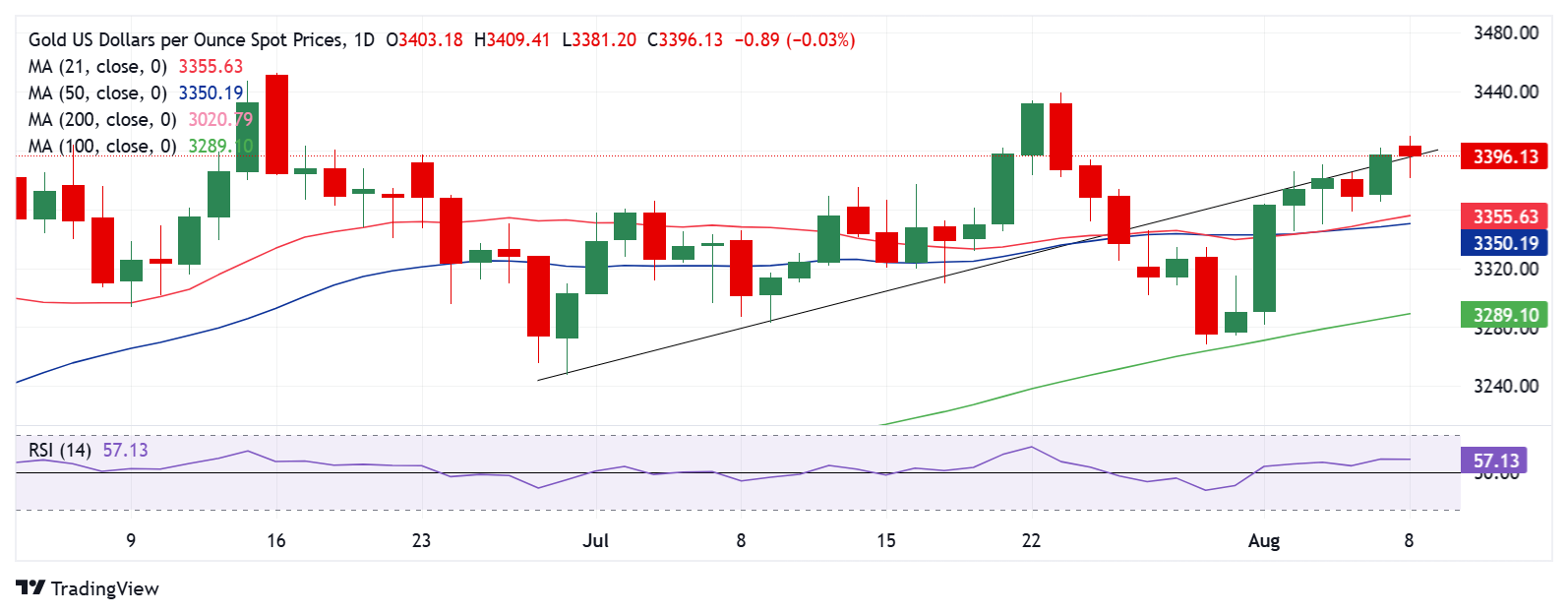
- Gold price hit two-week highs near $3,410 on US tariffs on one-kilo Gold bars, then retreats so far this Friday.
- The US Dollar eyes a weekly loss amid Fed, economic and trade concerns, focus shifts to US CPI data.
- Gold price could retest $3,350 confluence support if profit-taking intensifies heading into the weekend.
Gold price is seeing a sharp pullback after hitting fresh two-week highs near $3,410 early Friday. Traders digest the latest tariff headlines as the bright metal heads for a second straight weekly advance.
Gold price retreat appears temporary
The latest leg lower in Gold price is largely seen on the back of profit-taking as traders cash in on the spike in Gold futures to fresh record highs.
This follows a Financial Times (FT) report on Thursday, citing a letter from Customs Border Protection that stated the United States (US) has imposed tariffs on imports of one-kilo Gold bars.
Despite the corrective move lower, Gold price will continue to draw safe-haven flows as traders believe the tariffs on Gold bars are likely to cause a big disruption in trade from Switzerland and London. Note that Switzerland is the world’s largest Gold refining hub.
On Thursday, US President Donald Trump’s higher reciprocal tariffs on imports from dozens of countries took effect, with heavy levies on Switzerland, Brazil and India. Trump also threatened additional tariffs on China and Japan against their oil imports from Russia.
Concerns over the impact of tariffs on the already dwindling US economic momentum remain a drag on market sentiment and the US Dollar (USD), limiting any downside in Gold price.
Additionally, investors remain wary about the independence of the US Federal Reserve (Fed) even after Trump nominated Council of Economic Advisers Chairman Stephen Miran to replace Fed Governor Adriana Kugler. Miran is also seen replacing Jerome Powell when his term ends in May 2026.
Furthermore, markets are now expecting the Fed to cut interest rates by a total of 100 basis points (bps), starting later this year and finishing early next year, in the face of renewed economic and trade worries.
The discouraging sentiment around the Fed continues to undermine the performance of the US Dollar (USD) while keeping the ‘dip-buying’ interest around Gold price intact.
However, Gold price remains at risk of further correction due to the repositioning ahead of next week’s crucial US Consumer Price Index (CPI) inflation data.
Gold price technical analysis: Daily chart

Gold time is battling the critical barrier at $3,395, although the bias remains positive amid a Bull Cross in play and a bullish daily Relative Strength Index (RSI).
The leading indicator holds comfortably above the midline, currently near 57, suggesting that the bullish potential remains intact in Gold price.
The 21-day closed above the 50-day SMA on Tuesday, confirming a Bull Cross.
Gold price needs a weekly closing above the rising trendline support-turned-resistance at $3,395 for a sustained uptrend toward the record highs of $3,500.
Ahead of that, the $3,440 static hurdle and the June 16 high of $3,453 will challenge bearish commitments.
To the downside, strong support is placed at the 21-day SMA and 50-day SMA confluence near $3,350. Acceptance below that level will unleash additional downside toward the $3,300 round figure. Deeper declines will challenge the 100-day SMA at $3,289.
Gold FAQs
Gold has played a key role in human’s history as it has been widely used as a store of value and medium of exchange. Currently, apart from its shine and usage for jewelry, the precious metal is widely seen as a safe-haven asset, meaning that it is considered a good investment during turbulent times. Gold is also widely seen as a hedge against inflation and against depreciating currencies as it doesn’t rely on any specific issuer or government.
Central banks are the biggest Gold holders. In their aim to support their currencies in turbulent times, central banks tend to diversify their reserves and buy Gold to improve the perceived strength of the economy and the currency. High Gold reserves can be a source of trust for a country’s solvency. Central banks added 1,136 tonnes of Gold worth around $70 billion to their reserves in 2022, according to data from the World Gold Council. This is the highest yearly purchase since records began. Central banks from emerging economies such as China, India and Turkey are quickly increasing their Gold reserves.
Gold has an inverse correlation with the US Dollar and US Treasuries, which are both major reserve and safe-haven assets. When the Dollar depreciates, Gold tends to rise, enabling investors and central banks to diversify their assets in turbulent times. Gold is also inversely correlated with risk assets. A rally in the stock market tends to weaken Gold price, while sell-offs in riskier markets tend to favor the precious metal.
The price can move due to a wide range of factors. Geopolitical instability or fears of a deep recession can quickly make Gold price escalate due to its safe-haven status. As a yield-less asset, Gold tends to rise with lower interest rates, while higher cost of money usually weighs down on the yellow metal. Still, most moves depend on how the US Dollar (USD) behaves as the asset is priced in dollars (XAU/USD). A strong Dollar tends to keep the price of Gold controlled, whereas a weaker Dollar is likely to push Gold prices up.
Information on these pages contains forward-looking statements that involve risks and uncertainties. Markets and instruments profiled on this page are for informational purposes only and should not in any way come across as a recommendation to buy or sell in these assets. You should do your own thorough research before making any investment decisions. FXStreet does not in any way guarantee that this information is free from mistakes, errors, or material misstatements. It also does not guarantee that this information is of a timely nature. Investing in Open Markets involves a great deal of risk, including the loss of all or a portion of your investment, as well as emotional distress. All risks, losses and costs associated with investing, including total loss of principal, are your responsibility. The views and opinions expressed in this article are those of the authors and do not necessarily reflect the official policy or position of FXStreet nor its advertisers. The author will not be held responsible for information that is found at the end of links posted on this page.
If not otherwise explicitly mentioned in the body of the article, at the time of writing, the author has no position in any stock mentioned in this article and no business relationship with any company mentioned. The author has not received compensation for writing this article, other than from FXStreet.
FXStreet and the author do not provide personalized recommendations. The author makes no representations as to the accuracy, completeness, or suitability of this information. FXStreet and the author will not be liable for any errors, omissions or any losses, injuries or damages arising from this information and its display or use. Errors and omissions excepted.
The author and FXStreet are not registered investment advisors and nothing in this article is intended to be investment advice.







